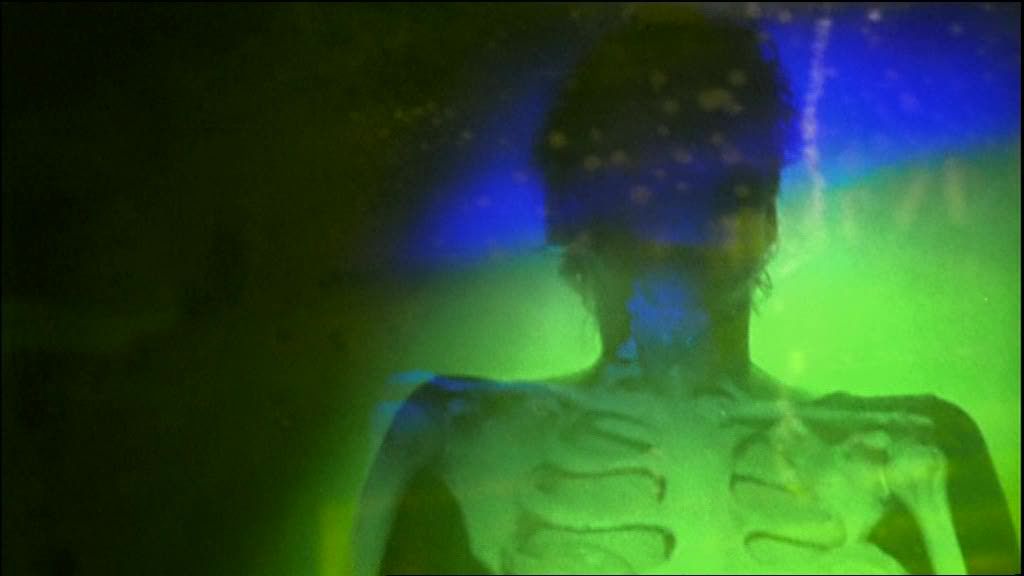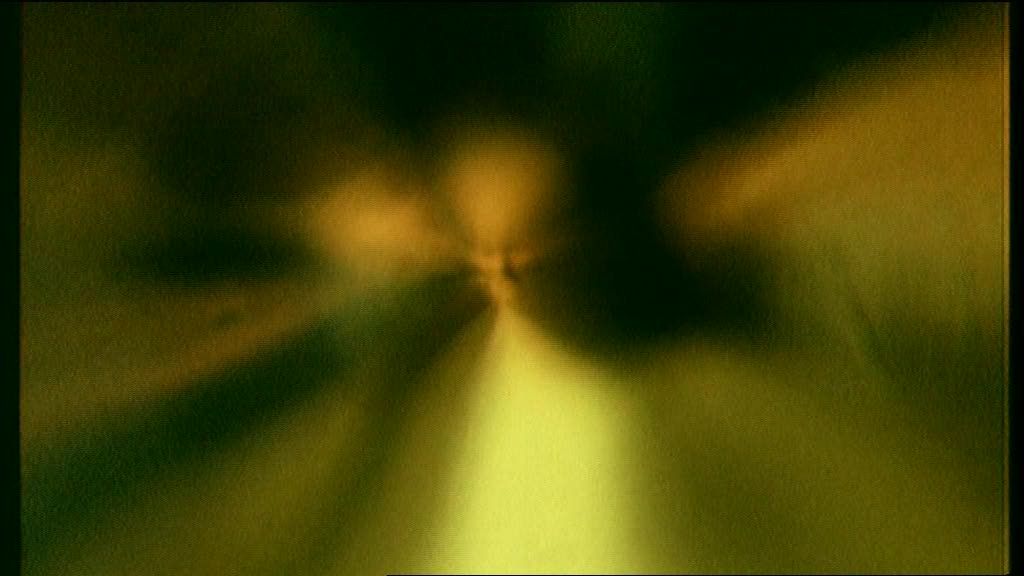
Paranoid Park opens with an oddly unsettling credit sequence, a gorgeous static shot of a bridge on a dark, overcast day, threatening dark blue clouds hanging in the background over a pastoral scene. The landscape looks like it was cut-and-pasted from Hitchcock's chipper rural fantasia The Trouble With Harry, while the clouds and the air of foreboding might've come from the heavily painted backdrops of The Birds. There's something eerily artificial about this view that is reminiscent of Hitchcock's fondness for matte-painting backgrounds, even though here the scene is entirely natural. It's not surprising that director Gus Van Sant's images would subliminally hark back to Hitchcock in this way — after all, he has already paid homage to the master by remaking and deconstructing Psycho — but the film this shot introduces actually owes very little debt to Van Sant's acknowledged influence. As though driving this home, immediately after the proper credits there is in effect a second credit sequence, a close-up on a sheet of looseleaf paper as a pencil writes the film's title in juvenile handwriting sloppily across the page.
This second "credits sequence," in which the film's central character Alex (Gabe Nevins) starts writing a lengthy letter, is much more in keeping with the spirit of the film as a whole: it is rough, homemade, amateurish, perfectly attuned to the high school mentality that Van Sant aims to explore. In many ways, the film is a summation of Van Sant's career so far, from the rugged semi-documentary Mala Noche to the rigorous Bela Tarr-influenced "death trilogy" that immediately preceded this film. In fact, given the basic premise here — a skater kid accidentally kills a railroad security guard and is haunted by this tragedy — it's tempting to lump this film in with Van Sant's recent loose trilogy, but it doesn't quite fit. There are moments and techniques in Paranoid Park that seem to have developed naturally from the films that preceded it, like the endless tracking shots of Alex and his skater friends walking through the halls of the high school (cf. Elephant) or through the grassy hills in the area (Gerry). But in other ways the film moves beyond its predecessors, incorporating a rich pastiche of different types of material. Alex's narrative, shot with Van Sant's typical fluid, visually pristine cinematography, is subsumed within a patchwork structure that jumps unpredictably through time and includes frequent detours into abstract interludes or sequences that might have come from a skateboarding documentary, shot on grainy low-quality film stock with artfully off-center compositions capturing the quickly moving skaters.

The film is further marked by Van Sant's use of amateur actors, a practice he's often turned to but rarely with such commitment: not since his first film Mala Noche has he placed such an obviously untrained and technically unskilled cast in front of the camera at such length, with so much dialogue to work through. It's a choice that could have easily backfired, but the actors, mostly real high schoolers and skaters who had never acted before, wind up infusing the film with verisimilitude. This is especially true of Alex's narration, as he reads from the letter that he's writing throughout the film. His subjective perspective dictates the film's structure, his story jumping randomly through time as he simply pours his impressions onto the page, forgetting details, jumping back to fill them in later, continually skipping ahead and doubling back. Some scenes play out twice, once in broad outlines with Alex supplying the gist of the scene in voiceover, and then again in full, with the dialogue filled in completely.
His reading of this material is perfect, hesitant and constantly interrupted by awkward pauses or passages where he simply runs the words together without inflection. He sounds like a kid reading his book report aloud to a class, which is of course exactly what he should sound like. Van Sant is brave enough to really commit to this awkwardness, riding it out even when the results are as painful to watch as remembering your own embarrassing teenage moments. A conversation between Alex and his friend Macy (Lauren McKinney) is almost unbearable, its rhythms completely off-kilter in the way that only terminally shy adolescents can manage. You can feel the affection between these two as well as the insecurity and self-consciousness, the way they can sometimes barely get out their thoughts without endless pauses, and other times run everything together in a nervous jumble. It's oddly endearing only because it feels so shockingly real.

This awkwardness and nervousness extends throughout the film, and it's hardly limited to the traumatic event that Alex experiences when he witnesses the railroad guard's gory accidental death. Indeed, one of the ways in which Paranoid Park distinguishes itself from the so-called "death trilogy" is in its treatment of this death and its placement within the narrative structure. Gerry, Elephant, and Last Days can all be thought of as journeys towards death, documents of the time spent leading up to death, and ruminations on the sensationalist treatment of death in the media. They are truly films about death, about mortality, about violence, in a way that Paranoid Park is not. The film's one act of violence is harrowing and narratively important, but it does not have the same thematic central place that violence and death hold in the other films. Moreover, Alex reacts to this death in much the same way as he reacts to a lot of the other confusing, scary, unfathomable things he encounters on a daily basis: schoolwork, his parents' impending divorce, the prospect of losing his virginity with a girl he barely even likes, the uncomfortableness he obviously feels around other people. He is especially awkward around grown-ups, and it's not hard to understand why considering the condescending way they talk to him. In one scene, his father tries to connect with him but his language is so stiff and formal it sounds like he's making a business proposal rather than having a chat with his son. It's apparent that the adults around Alex are no more sure of themselves or in control than the teens they're supposed to be raising.
In this context, the death Alex causes is an extension of his general teenage insecurity, just one more thing to worry about. In an inversion of the usual priorities, death has become a metaphor for the trials of puberty, a distortion of scale that is wholly in keeping with the high schooler's outsized sense of his personal troubles. Van Sant privileges this perspective by infusing the film with Alex's own personal sense of things: his blurry view of the world, the expansion of individual moments into endless periods of contemplation. Van Sant makes liberal use of slow motion and extended static shots, drawing out these contemplative interludes into lengthy studies of Alex's internality and disconnection. In one of the film's finest shots, Alex takes a shower immediately after the accident, and the camera focuses steadily on his bowed head, his shaggy hair hanging down over his face. The individual spikes of hair let off long rivulets of water, flowing in slow motion like rivers of shifting light growing from Alex's head. The light in the scene subtly shifts from shadowy to luminescent, and the composition almost verges into abstraction even as it maintains its roots in Alex's expression of misery.
The sound design in this scene is also stunning, as it is throughout the film. Playing off of the rainforest wallpaper in the shower behind Alex, the soundtrack consists of electronically modified bird chirps and rain, slowly warping into a shrill, intensifying sine hum, morphing from tranquil natural sounds into an overpowering mirror of Alex's internal strife. Van Sant's use of sound is always remarkably sensitive, whether he's layering and subtly tweaking natural sounds like this, subtly referencing Fellini by bringing in chunks of Nino Rota's scores for Juliet of the Spirits and Amarcord, or tastefully incorporating pop songs, as he does with two sad, yearning Elliot Smith tracks. Many of the skateboarding scenes are accompanied by glitchy, languid electronic music that brings to mind Robert Ashley's seminal minimalist composition "Automatic Writing," with processed traces of whispery voices skittering across a surface of droning electronic tones. This haunting, ghost-like music is surprisingly appropriate for the documentary-like skateboarding scenes, bringing a sense of wistfulness and nostalgia to the kind of footage that is usually accompanied with high-voltage jock rock. This collage of music and sounds drawn from many different sources contributes greatly to the film's tonal ambiguity, as the bouncy whimsy of the Rota music grates up against the more downbeat selections. There's a sense that, just as Alex doesn't quite know what to feel or what to say, Van Sant wants to leave his audience with similar sensations, a similar incompleteness and lack of resolution. His film captures the awkwardness and insecurity of adolescence but doesn't attempt to explain it; his characters always maintain their mysterious surfaces, their slow motion smiles and stares giving away little of their interior lives.




